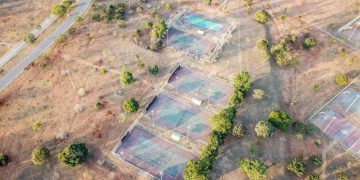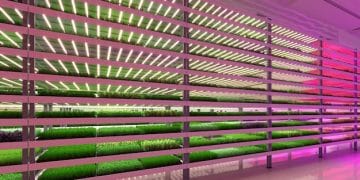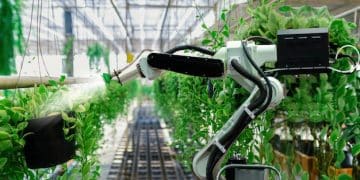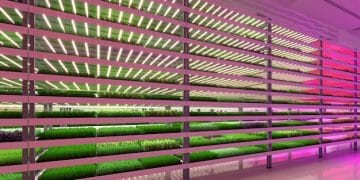Smart Greenhouses: IoT for Energy Efficiency & Crop Production

Smart greenhouses leverage IoT technology to optimize energy consumption and environmental conditions, leading to enhanced crop yields and sustainable agricultural practices.
Smart Greenhouses: Maximizing Energy Efficiency and Crop Production with IoT Technology is revolutionizing agriculture. These innovative structures utilize the Internet of Things (IoT) to create optimal growing conditions, reduce energy consumption, and ultimately increase crop yields. Explore how this technology is shaping the future of farming.
Understanding Smart Greenhouses
Smart greenhouses represent a significant leap forward in agricultural technology. They integrate various sensors, actuators, and control systems to create a tightly controlled environment where crops can thrive, regardless of external weather conditions.
These greenhouses utilize real-time data to adjust temperature, humidity, lighting, and irrigation, ensuring optimal conditions for plant growth. This leads to increased yields, reduced resource consumption, and improved overall efficiency.

Key Components of a Smart Greenhouse
Several key components work together to create a functional smart greenhouse:
- Sensors: These devices monitor environmental conditions such as temperature, humidity, light levels, soil moisture, and CO2 concentration.
- Actuators: These devices respond to the data collected by the sensors, adjusting parameters like ventilation, heating, cooling, irrigation, and lighting.
- Control System: This system processes the sensor data and controls the actuators to maintain the desired environmental conditions.
- Connectivity: Enables remote monitoring and control of the greenhouse, allowing farmers to make adjustments from anywhere with an internet connection.
The integration of these components allows for precise control over the growing environment, leading to significant improvements in crop production and resource utilization.
In conclusion, smart greenhouses are transforming agriculture by providing a controlled and optimized environment for plant growth, leading to increased efficiency and sustainability.
Energy Efficiency in Smart Greenhouses
One of the primary benefits of smart greenhouses is their ability to significantly improve energy efficiency. Traditional greenhouses often consume large amounts of energy for heating, cooling, and lighting. Smart greenhouses, however, use data-driven automation to minimize energy waste.
By precisely controlling environmental conditions and using energy-efficient technologies, smart greenhouses can dramatically reduce their carbon footprint and lower operating costs.
Strategies for Energy Conservation
Smart greenhouses employ a variety of strategies to conserve energy:
- Optimized Lighting: Using LED lighting systems that provide the exact spectrum and intensity needed by plants, while consuming significantly less energy than traditional lighting.
- Precise Climate Control: Implementing advanced climate control systems that adjust heating, cooling, and ventilation based on real-time data, minimizing energy consumption.
- Renewable Energy Integration: Integrating renewable energy sources such as solar panels and wind turbines to power the greenhouse.
- Thermal Insulation: Using high-quality insulation materials to reduce heat loss in winter and heat gain in summer.
These strategies enable smart greenhouses to operate more efficiently and sustainably, reducing their environmental impact.
In essence, smart greenhouses revolutionize energy efficiency by employing data-driven automation and advanced technologies to minimize energy consumption and reduce environmental impact.
IoT Technology in Smart Greenhouses
The Internet of Things (IoT) is the backbone of smart greenhouses, enabling the seamless integration of sensors, actuators, and control systems. IoT technology allows for real-time data collection, analysis, and response, creating a highly efficient and automated growing environment.
By connecting every aspect of the greenhouse to the internet, farmers can monitor and control the environment remotely, making informed decisions based on real-time data.
How IoT Enhances Greenhouse Management
IoT technology offers numerous benefits for greenhouse management:
- Remote Monitoring: Farmers can monitor environmental conditions and equipment status from anywhere using a smartphone, tablet, or computer.
- Automated Control: IoT devices can automatically adjust environmental parameters based on real-time data, ensuring optimal growing conditions.
- Predictive Analytics: IoT data can be used to predict potential problems, such as equipment failures or pest infestations, allowing farmers to take proactive measures.
- Data-Driven Decision Making: Farmers can analyze historical data to identify trends and optimize their growing practices.
The integration of IoT technology empowers farmers to manage their greenhouses more effectively and efficiently, leading to increased yields and reduced resource consumption.
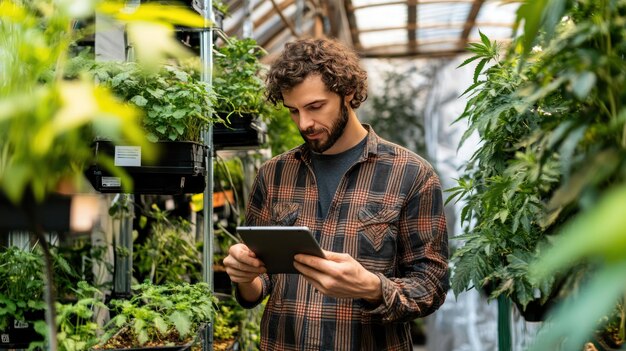
Ultimately, IoT technology is essential for the efficient operation of smart greenhouses, enabling remote monitoring, automated control, predictive analytics, and data-driven decision-making for optimized crop production.
Optimizing Crop Production with Smart Greenhouses
Smart greenhouses can significantly optimize crop production. The precise control over environmental conditions translates directly into improved plant health, faster growth rates, and higher yields.
By providing the ideal conditions for each crop, smart greenhouses can produce more food with fewer resources, addressing the growing demand for sustainable agriculture.
Strategies for Maximizing Crop Yields
Here are some strategies to maximize crop yields in smart greenhouses:
- Customized Environmental Control: Adjusting temperature, humidity, lighting, and CO2 levels to meet the specific needs of each crop.
- Precision Irrigation: Using sensors to monitor soil moisture levels and delivering water only when and where it is needed, minimizing water waste.
- Nutrient Management: Monitoring nutrient levels in the soil and adjusting fertilizer applications to ensure optimal plant nutrition.
- Pest and Disease Control: Implementing integrated pest management strategies that minimize the use of pesticides while protecting crops from pests and diseases.
These strategies allow farmers to create the perfect growing environment for their crops, leading to significant increases in yield and quality.
In conclusion, smart greenhouses ensure optimum crop yields through tailored environmental control, precise irrigation, nutrient management, and integrated pest control.
Challenges and Considerations
Despite the many benefits, there are also challenges and considerations to keep in mind when implementing smart greenhouse technology. The initial investment can be significant, and ongoing maintenance and technical support are required.
It is crucial to carefully evaluate the costs and benefits before investing in a smart greenhouse system.
Addressing Common Challenges
Here are some common challenges and how to address them:
- High Initial Cost: Develop a detailed business plan to justify the investment and explore financing options.
- Technical Complexity: Invest in training and ongoing support to ensure that staff can operate and maintain the system effectively.
- Data Security: Implement robust cybersecurity measures to protect sensitive data from unauthorized access.
- Integration with Existing Systems: Ensure that the smart greenhouse system can be integrated with existing farm management software and other systems.
By addressing these challenges proactively, farmers can maximize the return on their investment in smart greenhouse technology.
By properly handling these issues, farmers can optimize their investment in smart greenhouse technology and attain the projected benefits.
The Future of Smart Greenhouses
The future of smart greenhouses is bright, with ongoing advancements in technology promising even greater efficiency and productivity. As IoT technology continues to evolve, we can expect to see more sophisticated and integrated systems that further optimize crop production.
Smart greenhouses are poised to play a crucial role in addressing the challenges of food security and sustainable agriculture in the years to come.
Emerging Trends in Smart Greenhouses
Here are some emerging trends to watch:
- Artificial Intelligence (AI): Using AI to analyze data and make real-time adjustments to optimize environmental conditions.
- Robotics: Deploying robots to automate tasks such as planting, harvesting, and pest control.
- Vertical Farming: Integrating smart greenhouse technology into vertical farming systems to maximize space utilization.
- Blockchain Technology: Using blockchain to track and trace crops throughout the supply chain, ensuring transparency and food safety.
In the future, these innovations will help smart greenhouses to become even more efficient, productive, and sustainable.
In short, the future of smart greenhouses is promising, with AI, robotics, vertical farming, and blockchain all improving efficiency and sustainability.
| Key Aspect | Brief Description |
|---|---|
| 💡 IoT Integration | Real-time data collection for optimized control. |
| 🌱 Crop Optimization | Customized environments for enhanced yields. |
| ⚡ Energy Efficiency | Reduced consumption with smart climate control. |
| 🤖 Future Trends | AI, robotics, and vertical farming integration. |
Frequently Asked Questions
▼
A smart greenhouse uses IoT technology to monitor and control environmental factors such as temperature, humidity, and lighting, optimizing plant growth.
▼
IoT enables remote monitoring and automated adjustments, ensuring ideal conditions and minimizing wasted resources like energy and water.
▼
LED lighting provides the specific light spectrum needed for plant growth with substantially lower energy consumption compared to traditional lighting.
▼
Predictive analytics can identify potential issues like equipment failure or pest infestations early, allowing for timely intervention and preventing significant losses.
▼
AI analyzes data and automatically adjusts conditions in real-time. These actions can significantly boost efficiency and productivity by using predictive patterns.
Conclusion
Smart greenhouses represent a transformative approach to agriculture, leveraging IoT technology to maximize energy efficiency and crop production. From optimizing environmental conditions to predicting potential problems, these innovative structures offer a sustainable and efficient way to meet the growing demand for food. Embracing smart greenhouse technology is not just an investment in the future of farming, but also a step towards a more sustainable and secure food supply.
